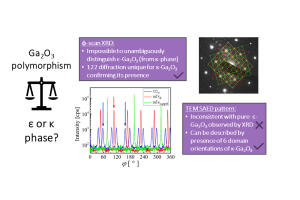Mysterious crystal

Crystalline gallium oxide (Ga2O3) represents a new type of semiconductor material suitable for the realization of high-voltage electronic devices capable of operating in the unprecedented kilovolt range. Our colleagues have recently published a paper detailing the material properties of Ga2O3 epitaxial layers prepared at the IEE SAS.
Ga2O3 crystallizes in several crystalline structures (polymorphs). Among the most common monoclinic structure (β), the hexagonal structure (ε) is extremely interesting due to its potential integration with other compound semiconductors such as GaN (used for white LEDs production). However, it turns out that the Ga2O3 epitaxial layers, originally identified as hexagonal, actually crystallize in an orthorhombic structure (κ). This is due to the fact that both phases show the same fingerprint in standard X-ray diffraction method (XRD), commonly used in materials analysis. In our work, we have analyzed the possibility of distinguish between ε and κ phases of Ga2O3 by XRD. Ga2O3 thin films (~120 nm) were grown by metalorganic chemical vapor deposition (MOCVD). Thanks to a detailed study of both crystal structures, we have shown that despite the identification of the ε-Ga2O3 phase by means of φ-scans XRD, the presence of a κ-Ga2O3 phase cannot be ruled out. On the other hand, we have found such diffraction of the κ-Ga2O3 phase, which is forbidden in the hexagonal structure. The identification of this diffraction then unambiguously confirms the existence of the κ-Ga2O3 phase. Presence of this phase was also confirmed by transmission electron microscopy (TEM). We also studied thermal stability of κ-Ga2O3 layers annealed in vacuum. The films were found to be thermally stable up to 1 100°C despite the metastability of this polymorph.

Structure and Thermal Stability of ε/κ-Ga2O3 Films Deposited by Liquid-Injection MOCVD ( Materials 16, 2023, 20)
 Contact
Contact Intranet
Intranet SK
SK

